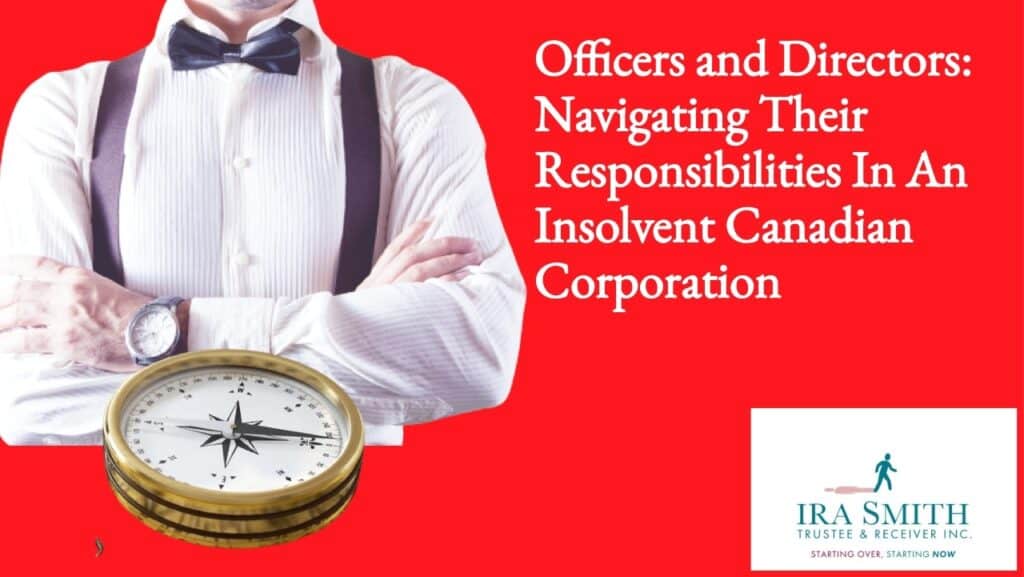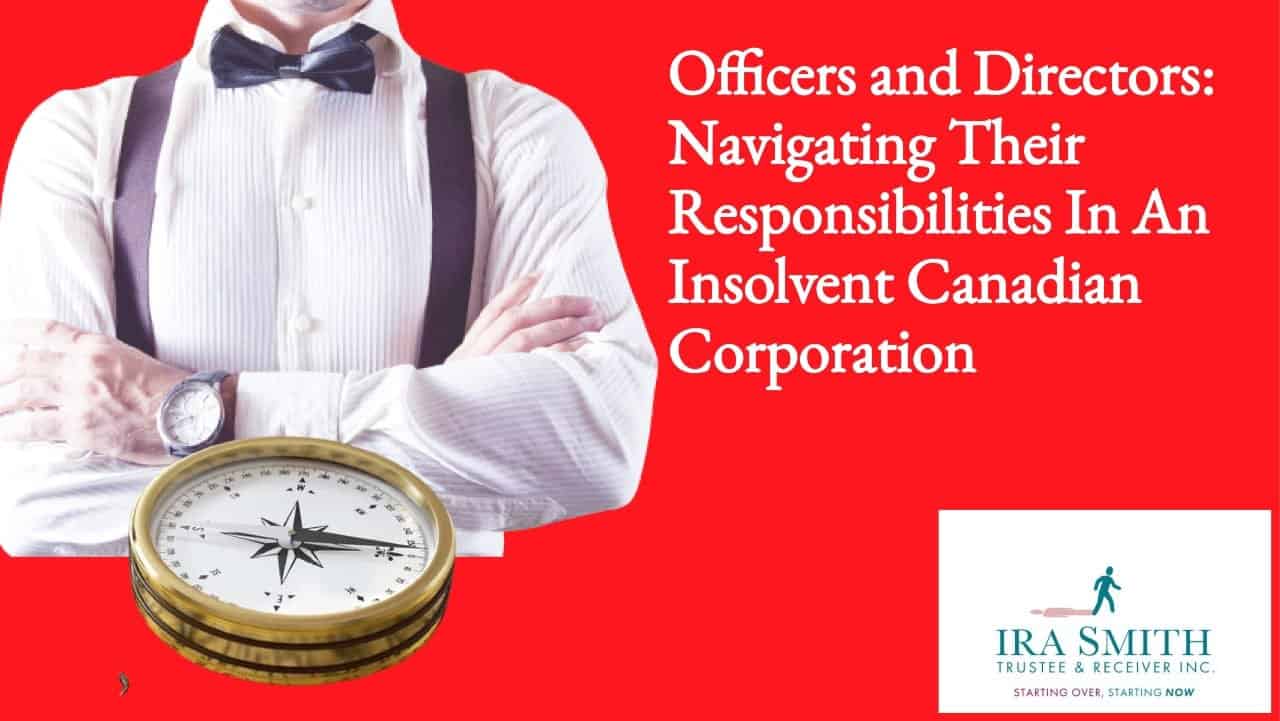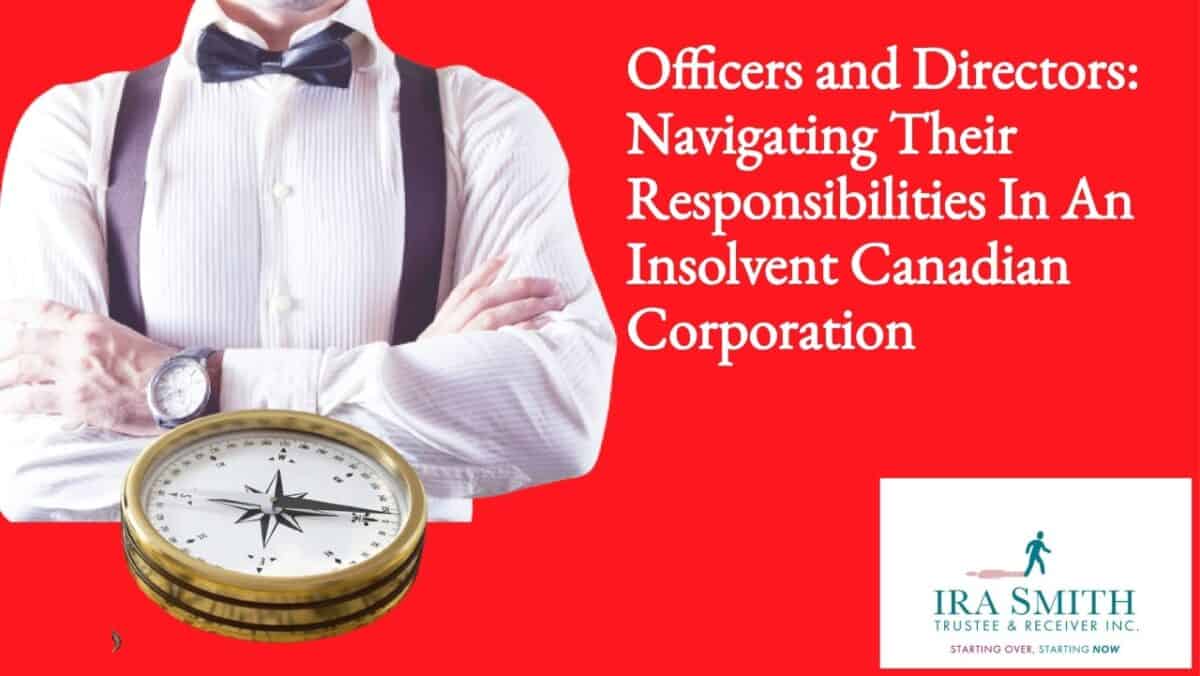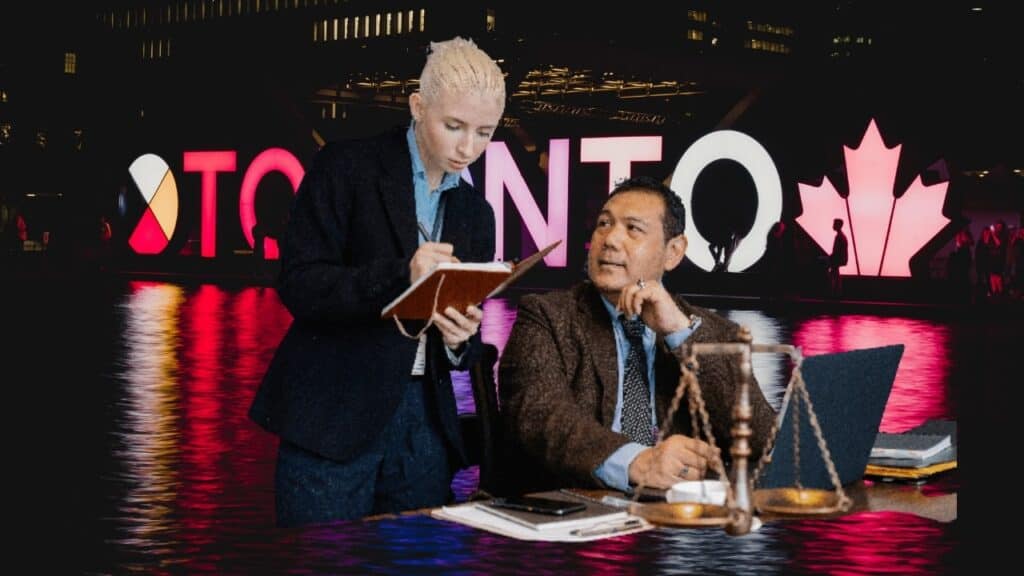officers and directors
Officers and Directors: Introduction
In Canada, it is essential that the individual orchestrating any criminal activity must have the necessary competency to commit the offence before any corporate responsibility can be assumed. The executives and board members of the enterprise are viewed as the ultimate custodians of the company’s ethical obligations.
Welcome to Brandon’s Blog! Here I’ll be discussing the court’s ruling on fraudulent intent by officers and directors, and how it affects the transfer of assets at undervalue in insolvent corporations. I’ll be focusing on the 2022 Court of Appeal for Ontario decision in the Bondfield Construction Company Limited (“Bondfield”) and Forma-Con Construction (“Forma-Con”) case as creating new law.
After two court decisions over nearly two years, the Supreme Court of Canada has delivered their decision on the Court of Appeal’s decision upholding the lower court decision, granting the application for leave to appeal to the Supreme Court.
Officers and Directors: What is the “directing mind”?
The term “directing mind” in the context of Canadian corporations refers to a natural person who holds a high level of authority within theand can be considered the “alter ego or soul” of the corporation. The term “alter e organization go” or “soul” of a corporation refers to a person who holds significant authority within the organization. According to the web search results, this person can be considered the embodiment or representation of the corporation.
Federal legislation uses a more familiar expression for the directing mind “senior officer”. This includes individuals who have an important role in setting policy or making important decisions within the corporation. A “senior officer” is a person in a position of authority or seniority over others. They are responsible for leading and overseeing a group or organization.

The duties of Officers and Directors
Fiduciary Duty
In Canada, the phrase “directing mind” is used to refer to a top-tier individual, an officer or someone on the board of directors in a company who can be thought of as its “alter ego” or “soul”. This individual holds a great degree of influence and power within the corporation, making them its symbolic heart and soul.
Duty of Care
Officers and directors are expected to exercise the same degree of prudence, attention to detail, and knowledgeability that any reasonable individual would in similar scenarios. This means that they must stay abreast of the corporation’s financial well-being and make informed decisions using that information. Beyond the necessity of performing their fiduciary duty, they also have a duty of care to the company and its stakeholders.
Insolvency and the Obligations of Officers and Directors in Canadian Corporations
As a corporation’s liabilities come due and it finds itself unable to pay, insolvency looms large. This can be a stressful period for corporate officers and directors, as they are tasked with making crucial decisions that will affect the company and its stakeholders in the long run. It is paramount that they keep the corporation’s best interests in mind as they navigate these difficult waters.
Officers and directors of Canadian corporations have two significant legal obligations to fulfill: a fiduciary duty and a duty of care. Failure to uphold either of these duties could result in personal liability for them.

Navigating Responsibilities in an Insolvent Corporation: Do officers and directors owe a duty to creditors
When an enterprise finds itself insolvent or close to it, the officers and directors of the company accept a nerve-wracking assignment. These decision-makers are required to make authoritative choices that will determine the fate of the corporation and of all those involved.
Officers and directors of an insolvent company must jump into action to protect as best as possible the corporation and its stakeholders from added losses. This could include negotiations with creditors, liquidating redundant assets, and reorganizing the firm’s procedures. It’s not a simple task, but it’s a necessary one.
It’s necessary to protect the corporation and its stakeholders by focusing on the company’s important resources and operations. Decisions must be made to stave the loss of assets needed to operate and make sure that all of its transactions are in the corporation’s best interests.
Aside from their approved responsibilities, officers and directors need to be alert to their obligations and the repercussions that may arise from negligence. They need to be very careful to ensure that their fiduciary responsibility and duty of care are not abandoned and must correct any missteps.
With this perfect segway, I now wish to describe a very important recent decision from the Court of Appeal for Ontario upholding the lower court decision on the duties and responsibilities of officers and directors of an insolvency company. This decision has been appealed to the Supreme Court of Canada. It is such an important decision for officers and directors, corporations and especially insolvent ones for the entire country, that the Supreme Court of Canada has agreed to hear the appeal.
Officers and directors: Ernst & Young Inc. v. Aquino, 2022 ONCA 202 (CanLII)
On March 10, 2022, the Court of Appeal made a landmark decision in Ernst & Young Inc. v. Aquino, which delved into the corporate attribution doctrine – the idea that the actions of a corporation’s controlling figure can be attributed to the firm itself. The ruling was especially pertinent in the bankruptcy and insolvency context.
John Aquino was the directing mind of Bondfield Construction Company Limited (“Bondfield”) and its affiliate Forma-Con Construction (“Forma-Con”). He and his associates carried out a false invoicing scheme over a number of years by which they siphoned off tens of millions of dollars from both companies.
The monitor and the trustee challenged the false invoicing scheme and sought to recover some of the money. The participants argue that they did not intend to defeat any actual creditors and that John Aquino’s intent cannot be imputed to either Bondfield or Forma-Con.
Bondfield was a full-service group of construction companies that operated in the Greater Toronto Area and Southern Ontario starting in the mid-1980s. Bondfield was in financial trouble in 2018 and started proceedings under the CCAA on April 3, 2019.
After a careful investigation, the monitor and the licensed insolvency trustee administering the bankruptcy (formerly called a trustee in bankruptcy) uncovered a shocking discovery: Bondfield and Forma-Con had deceitfully dispersed a staggering sum of money to or for the benefit of John Aquino and others via a fraudulent invoicing system!
In cross-examination, Mr. Aquino admitted that the suppliers who falsely invoiced Bondfield provided no value for the transfers, but denied intent to defraud, defeat, or delay Bondfield’s actual creditors.

Can section 96 of the Bankruptcy and Insolvency Act (“BIA”) be used by the monitor and the trustee to recover the money officers and directors took from Bondfield and Forma-Con?
Section 96 of the BIA allows trustees to seek a court order “voiding transfers at undervalue” which are a transfer by the debtor to another party at no or undervalued consideration, which is an improvident transaction from the debtor’s perspective. The policy of the BIA goes beyond the modest origin of the law, which prohibits insolvent debtors from giving away assets to third parties instead of using those assets to repay their debts.
This section of the BIA is a remedy to reverse an improvident transfer that strips value from the debtor’s estate, but the trustee must nevertheless meet the requirements of the specific words used.
The monitor and the trustee had to prove two elements to require John Aquino and the other beneficiaries of the false invoicing scheme to repay the money they took under s. 96(1)(b)(ii)(B) of the BIA. The application judge bridged the gap by imputing John Aquino’s fraudulent intention to the debtors, Bondfield and Forma-Con.
The legal analysis of the false invoicing scheme was no longer in active dispute. John Aquino and his associates dispute liability under s. 96 on the basis that their fraudulent acts were not carried out at a time when Bondfield and Forma-Con were financially precarious.
John Aquino and his associates asserted that Bondfield and Forma-Con were financially healthy, so they did not intend to defraud any actual creditors. When assessing the intention of a debtor, a court must look at the information known at the time of the transfer or transaction, and the reasonableness of the debtor’s belief in light of the circumstances then existing.
In order to require John Aquino and the other beneficiaries of the false invoicing scheme to repay the money they took under s. 96(1)(b)(ii)(B) of the BIA, the monitor and the trustee had to prove two elements: first, John Aquino and the other participants were not dealing with Bondfield and Forma-Con at arm’s length; and second, at the time they took the money (during the statutory review period), they “intended to defraud, defeat or delay a creditor” of Bondfield or Forma-Con. The first element is amply established by the evidence. This case turns on the second element.
The lower court judge’s reasons for the timing of the transfers
The Court of Appeal found that the lower court judge decided correctly based on the legal principles that were presented. John Aquino and his associates presented their case of Bondfield and Forma-Con’s solvency when they received the funds. However, the judge decided that the affirmation of fraud provided an abundant base for deciding that Bondfield and Forma-Con had the purpose of deceiving, obstructing, or delaying their creditors.
The judge concluded that the presence of badges of fraud creates a presumption of fraudulent intent and that John Aquino had not rebutted the presumption. The judge also concluded that the true financial condition of Bondfield and Forma-Con at the time of each impugned transaction cannot be determined on the record before the court.
Based on the totality of the evidence, documents and information, the judge held that at the time of the fraudulent transactions, Bondfield and Forma-Con were already experiencing mounting financial difficulties, and their creditors were imperilled by the transfers. John Aquino continued on nonetheless, and the court found that the transfers were intended to defeat those creditors. The application judge took a pragmatic view of the evidence, found that John Aquino carried on with the false invoicing scheme knowing that Bondfield and Forma-Con were experiencing increasing financial difficulties, and inferred that he did this with the intent to defeat creditors.
John Aquino didn’t care if his scheme had the potential to defraud, defeat or delay creditors according to section 96 of the BIA. His recklessness was enough to show the intent needed to make the fraudulent transfers stand. It’s clear that he wasn’t concerned about the interests of the companies’ creditors.
Forma-Con paid over $11 million to certain purported suppliers under the false invoicing scheme during the time period of review allowed under s.96 of the BIA. For the Bondfield 5-year review period, the court found that the total amount of $21,807,693, are transfers at undervalue. The court ordered Mr. Aquino and associates, to repay this amount on a joint and several basis.

Officers and Directors: Uncovering the Impact of Fraudulent Intent on Transfers and Undervalue in Bankrupt Corporations
The application judge was able to uncover John Aquino’s scam involving false invoicing by Bondfield and Forma-Con, giving the trustee the green light under the BIA to reclaim the funds stolen by the fraudsters.
The appellants argue that the lower court judge erred legally because John Aquino’s fraudulent intent cannot be imputed to Bondfield or Forma-Con as a matter of law, even though he was one of their directing minds. They assert that the binding principles of the common law doctrine of corporate attribution set out in Canadian Dredge & Dock Co. v. The Queen,[55] do not permit the imputation of his intention to either defrauded the company. Accordingly, s. 96(1)(b)(ii)(B) of the BIA cannot be used to require John Aquino, or his associates as “privies” to the impugned transactions, to repay the money they took.
This intriguing argument brings up a difficult issue concerning the relationship between the stipulations of the BIA and common law doctrine. When can a court use common law in interpreting and putting the BIA into effect? I will start by presenting the judge’s rationale for the application. After that, I will tackle this legal inquiry and then consider its effects regarding the implementation of the corporate attribution doctrine in this appeal.
The lower court judge reasoned that common law doctrine can be enlisted by a court to interpret and supplement the BIA where necessary to better achieve its purposes, one of which is to protect the interests of the bankrupt’s creditors. She believed that common law can add content to the terms of the bankruptcy law not otherwise defined. In particular, the common law doctrine known as the anti-deprivation rule and its purpose of preventing fraud on the bankruptcy is especially pertinent in this case. The use of common law doctrine must respect the policy of the BIA.
The BIA is no stranger to the use of common law doctrines- though it has yet to officially codify ‘good faith’, the Supreme Court has nonetheless held that Parliament is expected to remain true to the traditional understanding of the common law unless there is some explicit and unmistakable indication of deviation. Consequently, when it comes to interpreting the BIA, the concept of good faith unquestionably plays a role, but it is not codified.
The fraud on bankruptcy law principle exists to protect creditors from unscrupulous parties who might otherwise try to remove value from an insolvent debtor’s assets. Corporations, being distinct from natural persons, necessitate the corporate attribution doctrine, which provides a link between the entity and the individual whose “guiding hand” propelled the corporation into action.
This kind of insolvency officers and directors case was novel in Canada
The corporate attribution doctrine has been applied in the fields of criminal and civil liability. Before this case, courts in Canada had yet to consider the doctrine in the bankruptcy and insolvency context under s. 96 of the BIA. The court recognized that the attribution exercise is grounded in public policy. These principles provide a sufficient basis to find that the actions of a directing mind be attributed to a corporation, not a necessary one.
Accordingly, as a principle that is grounded in policy, and which only serves as a means to hold a corporation criminally responsible or to deny civil liability, courts retain the discretion to refrain from applying it where, in the circumstances of the case, it would not be in the public interest to do so.
After thorough deliberation, the Court of Appeal sided with the lower court to declare that this case had implications for the public interest. It was determined that the invoicing scheme had been used as a way to fraudulently, obstructively, and detrimentally transfer funds to avoid payment to Bondfield’s and Forma Con’s creditors. The Court seeks to reverse these transactions and recover a total of $11,366,890 on behalf of Forma-Con’s creditors. For Bondfield’s creditors, the amount of $21,807,693,

The bottom line of Ernst & Young Inc. v Aquino
The lower court found and the Court of Appeal affirmed that decision that under s. 96 of the BIA, the payments by Bondfield and Forma-Con made in respect of the false invoices during the 12-month review period totalling for Bondfield, $21,807,693, and for Forma-Con, CDN$13,985,743 CAD and US$35,030 Are transfers at undervalue. Those that received these funds were ordered to repay them on a joint and several basis.
The Court of Appeal delved into some critical legal matters in their ruling, exploring the responsibilities insolvency practitioners must uphold, how much creditors should be able to expect, as well as the rights of everyone involved in bankruptcy proceedings. They also delved into the interpretation of the BIA and the reality of its application.
The Court decided that the BIA has to be implemented in a way that meets the expectations of the Act, and that insolvency professionals are to be held to a high standard of both expertise and responsibility.
At the beginning of this Brandon’s Blog, I mentioned this monumental case will be heard in the Supreme Court of Canada. As you can imagine, it will be a highly anticipated event in the insolvency world. And it won’t disappoint!
The ruling so far has had major implications for the insolvency industry, including the rights of creditors, officers and directors and insolvency practitioners. All in all, it was a groundbreaking decision that will shape the industry for years to come – and will no doubt be further shaped once the Supreme Court of the land hears the case and issues its decision.
Obligations and Responsibilities of the Board of Directors and Officers: Conclusion
The Ernst & Young Inc. v Aquino case was an important one for the insolvency industry and had far-reaching implications for the obligations of insolvency practitioners and the rights of creditors and other stakeholders. The Court of Appeal’s decision in the case was a clear and definitive ruling on a number of key legal issues, and it will likely have a lasting impact on the insolvency industry for many years to come.
I hope you enjoyed this officers and directors Brandon’s Blog.
Revenue and cash flow shortages are critical issues facing entrepreneurs and their companies and businesses. Are you now worried about just how you or your business are going to survive? Are you worried about what your fiduciary obligations are and not sure if the decisions you are about to make are the correct ones to avoid personal liability? Those concerns are obviously on your mind. Coming out of the pandemic, we are also now worried about its economic effects of inflation and a potential recession.
The Ira Smith Team understands these concerns. More significantly, we know the requirements of the business owner or the individual that has way too much financial debt. You are trying to manage these difficult financial problems and you are understandably anxious.
It is not your fault you can’t fix this problem on your own. The pandemic has thrown everyone a curveball. We have not been trained to deal with this. You have only been taught the old ways. The old ways do not work anymore. The Ira Smith Team makes use of new contemporary ways to get you out of your debt problems while avoiding bankruptcy. We can get you debt relief now.
We have helped many entrepreneurs and their insolvent companies who thought that consulting with a trustee and receiver meant their company would go bankrupt. On the contrary. We helped turn their companies around through financial restructuring.
We look at your whole circumstance and design a strategy that is as distinct as you are. We take the load off of your shoulders as part of the debt settlement strategy we will draft just for you.
We understand that people facing money problems require a lifeline. That is why we can establish a restructuring procedure for you and end the discomfort you feel.
Call us now for a no-cost consultation. We will listen to the unique issues facing you and provide you with practical and actionable ideas you can implement right away to end the pain points in your life, Starting Over, Starting Now.




